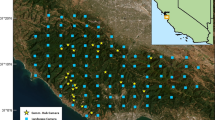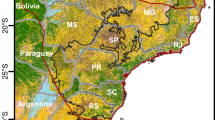Abstract
Dispersal decisions underlie the spatial dynamics of metacommunities. Prey individuals may disperse to reduce the risk of either predation or starvation, and both of these risks may depend on conspecific density. Surprisingly, there is little theory examining how dispersal rates should change in response to the combined effects of predation and changes in conspecific density. We develop such a model and show that, under certain conditions, predators may induce dispersal at low prey densities but not high prey densities. We then experimentally manipulate the density of the ciliate Paramecium aurelia and the perceived presence of its predator, the flatworm Stenostomum virginiamum, in a two-patch metacommunity to parameterise the model. Paramecium dispersed in response to Stenostomum at low densities, but they reduced their dispersal in response to predation risk at high predator densities. By applying our model to the empirical data, we show that this switch in dispersal strategy, linked to increases in prey density, occurred because predators increased the difficulty or risk of dispersal. Together, the model and experiment reveal that the effects of predators on dispersal are contingent on prey density. Previous studies have sometimes reported an increase in dispersal rate when predation risk is elevated, and other times a decrease in dispersal rate. Our demonstration of a switch point, with predation risk increasing dispersal at low prey densities but reducing dispersal above a threshold of prey density, may reconcile the diversity of prey dispersal behaviours reported in these previous investigations and observed in nature.



Similar content being viewed by others
References
Abrams PA (1993) Why predation rate should not be proportional to predator density. Ecology 74:726–733
Altwegg R, Marchinko KB, Duquette SL, Anholt BR (2004) Dynamics of an inducible defence in the protist Euplotes. Arch Hydrobiol 160:431–446
Anholt BR, Werner EE (1995) Interaction between food availability and predation mortality mediated by adaptive behavior. Ecology 76:2230–2234
Barraquand F, Murrell DJ (2012) Intense or spatially heterogeneous predation can select against prey dispersal. PLoS One 7:e28924
Boinski S, Kauffman L, Ehmke E, Schet S, Vreedzaam A (2005) Dispersal patterns among three species of squirrel monkeys (Saimiri oerstedii, S-boliviensis and S-sciureus): I. Divergent costs and benefits. Behaviour 142:525–632
Bronmark C, Lakowitz T, Nilsson PA, Ahlgren J, Lennartsdotter C, Hollander J (2012) Costs of inducible defence along a resource gradient. PLoS One 7:e30467
Cressman R, Krivan V (2013) Two-patch population models with adaptive dispersal: the effects of varying dispersal speeds. J Math Biol 67:329–358
Davenport JM, Chalcraft DR (2014) Increasing conspecific density weakens the ability of intermediate predators to develop induced morphological defences to top predators. Freshw Biol 59:87–99
Dehn MM (1990) Vigilance for predators—detection and dilution effects. Behav Ecol Sociobiol 26:337–342
Duquette SL, Altwegg R, Anholt BR (2005) Factors affecting the expression of inducible defences in Euplotes: genotype, predator density and experience. Funct Ecol 19:648–655
Frommen JG et al (2011) Costly plastic morphological responses to predator specific odour cues in three-spined sticklebacks (Gasterosteus aculeatus). Evol Ecol 25:641–656
Haegeman B, Loreau M (2014) General relationships between consumer dispersal, resource dispersal and metacommunity diversity. Ecol Lett 17:175–184
Hammill E, Beckerman AP (2010) Reciprocity in predator–prey interactions: exposure to defended prey and predation risk affects intermediate predator life history and morphology. Oecologia 163:193–202
Hammill E, Rogers A, Beckerman AP (2008) Costs, benefits and the evolution of inducible defences: a case study with Daphnia pulex. J Evol Biol 21:705–715
Hammill E, Kratina P, Anholt BR (2009) Non-lethal presence of predators modifies morphology and movement rates in Euplotes. Hydrobiologia 621:183–189
Hammill E, Kratina P, Beckerman AP, Anholt BR (2010a) Precise time interactions between behavioural and morphological defences. Oikos 119:494–499
Hammill E, Petchey OL, Anholt BR (2010b) Predator functional response changed by induced defenses in prey. Am Nat 176:723–731
Hanski I, Woiwod IP (1993) Spatial synchrony in the dynamics of moth and aphid populations. J Anim Ecol 62:656–668
Harvell CD (1990) The ecology and evolution of inducible defenses. Q Rev Biol 65:323–340
Hauzy C, Hulot FD, Gins A, Loreau M (2007) Intra- and interspecific density-dependent dispersal in an aquatic prey–predator system. J Anim Ecol 76:552–558
Hoare DJ, Couzin ID, Godin JGJ, Krause J (2004) Context-dependent group size choice in fish. Anim Behav 67:155–164
Holyoak M, Lawler SP (1996) Persistence of an extinction-prone predator–prey interaction through metapopulation dynamics. Ecology 77:1867–1879
Holyoak M, Lawler SP (2005) The contribution of laboratory experiments on protists to understanding population and metapopulation dynamics. Adv Ecol Res 37:245–271
Huffaker CB (1958) Experimental studies on predation: dispersion factors and predator–prey oscillations. Hilgardia 27:343–383
Kratina P, Vos M, Anholt BR (2007) Species diversity modulates predation. Ecology 88:1917–1923
Kunert G, Weisser WW (2003) The interplay between density- and trait-mediated effects in predator–prey interactions: a case study in aphid wing polymorphism. Oecologia 135:304–312
Kusch J, Kuhlmann HW (1994) Cost of Stenostomum-induced morphological defense in the ciliate Euplotes octocarinatus. Arch Hydrobiol 130:257–267
Lima SL, Dill LM (1990) Behavioral decisions made under the risk of predation—a review and prospectus. Can J Zoolog 68:619–640
Matthysen E (2005) Density-dependent dispersal in birds and mammals. Ecography 28:403–416
McIntosh AR, Peckarsky BL, Taylor BW (2002) The influence of predatory fish on mayfly drift: extrapolating from experiments to nature. Freshw Biol 47:1497–1513
Nachappa P, Margolies DC, Nechols JR, Campbell JF (2011) Variation in predator foraging behaviour changes predator–prey spatio-temporal dynamics. Funct Ecol 25:1309–1317
Poethke HJ, Weisser WW, Hovestadt T (2010) Predator-induced dispersal and the evolution of conditional dispersal in correlated environments. Am Nat 175:577–586
R Development Core Team (2011) R: a language and environment for statistical computing. R Foundation for Statistical Computing, Vienna
Rangeley RW, Kramer DL (1998) Density-dependent antipredator tactics and habitat selection in juvenile pollock. Ecology 79:943–952
Relyea RA, Werner EE (2000) Morphological plasticity in four larval anurans distributed along an environmental gradient. Copeia 2000:178–190
Rohani P, Ruxton GD (1999) Dispersal-induced instabilities in host–parasitoid metapopulations. Theor Popul Biol 55:23–36
Ryan MR, Killen SS, Gregory RS, Snelgrove PVR (2012) Predators and distance between habitat patches modify gap crossing behaviour of juvenile Atlantic cod (Gadus morhua, L. 1758). J Exp Mar Biol Ecol 422:81–87
Savill NJ, Hogeweg P (1999) Competition and dispersal in predator–prey waves. Theor Popul Biol 56:243–263
Schoeppner NM, Relyea RA (2008) Detecting small environmental differences: risk–response curves for predator-induced behavior and morphology. Oecologia 154:743–754
Skelly DK (1992) Field evidence for a cost of behavioral antipredator response in a larval amphibian. Ecology 73:704–708
Smith HL (1982) The interaction of steady-state and Hopf bifurcations in a 2-predator-one-prey competition model. Siam J Appl Math 42:27–43
Stearns SC (1976) Life-history tactics—review of ideas. Q Rev Biol 51:3–47
Steiner UK (2007) Linking antipredator behaviour, ingestion, gut evacuation and costs of predator-induced responses in tadpoles. Anim Behav 74:1473–1479
Stoks R (2001) Food stress and predator-induced stress shape developmental performance in a damselfly. Oecologia 127:222–229
Stoks R, McPeek MA, Mitchell JL (2003) Evolution of prey behavior in response to changes in predation regime: damselflies in fish and dragonfly lakes. Evolution 57:574–585
Taylor AD (1990) Metapopulations, dispersal, and predator prey dynamics—an overview. Ecology 71:429–433
Van Buskirk J, McCollum SA (2000) Functional mechanisms of an inducible defence in tadpoles: morphology and behaviour influence mortality risk from predation. J Evol Biol 13:336–347
Van Buskirk J, Ferrari M, Kueng D, Napflin K, Ritter N (2011) Prey risk assessment depends on conspecific density. Oikos 120:1235–1239
van Uitregt VO, Hurst TP, Wilson RS (2012) Reduced size and starvation resistance in adult mosquitoes, Aedes notoscriptus, exposed to predation cues as larvae. J Anim Ecol 81:108–115
Weisser W (2001) The effects of predation on dispersal. In: Clobert J, Danchin E, Dhondt A, Nichols J (eds) Causes, consequences and mechanisms of dispersal at the individual, population and community level. Oxford University Press, New York, pp 180–188
Werner EE, Anholt BR (1996) Predator-induced behavioral indirect effects: consequences to competitive interactions in anuran larvae. Ecology 77:157–169
Acknowledgments
We would like to thank Owen Petchey, Jeff Shima, Frederic Barraquand and the members of the Srivastava lab group for their insightful comments during the development of this project. This work was funded by an NSERC E.W.R. Steacie Memorial Fellowship awarded to D.S.S. All applicable institutional and/or national guidelines for the care and use of animals were followed.
Conflict of interest
The authors have no conflicts of interest to declare.
Author information
Authors and Affiliations
Corresponding author
Additional information
Communicated by Jeff Shima.
Electronic supplementary material
Below is the link to the electronic supplementary material.
Rights and permissions
About this article
Cite this article
Hammill, E., Fitzjohn, R.G. & Srivastava, D.S. Conspecific density modulates the effect of predation on dispersal rates. Oecologia 178, 1149–1158 (2015). https://doi.org/10.1007/s00442-015-3303-9
Received:
Accepted:
Published:
Issue Date:
DOI: https://doi.org/10.1007/s00442-015-3303-9




